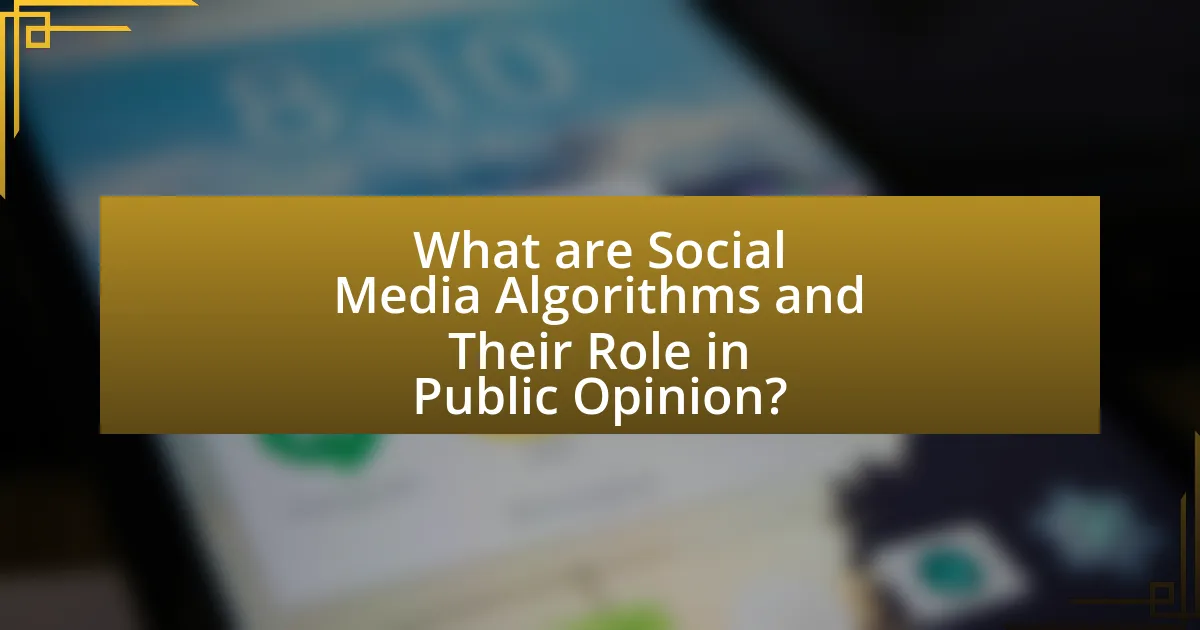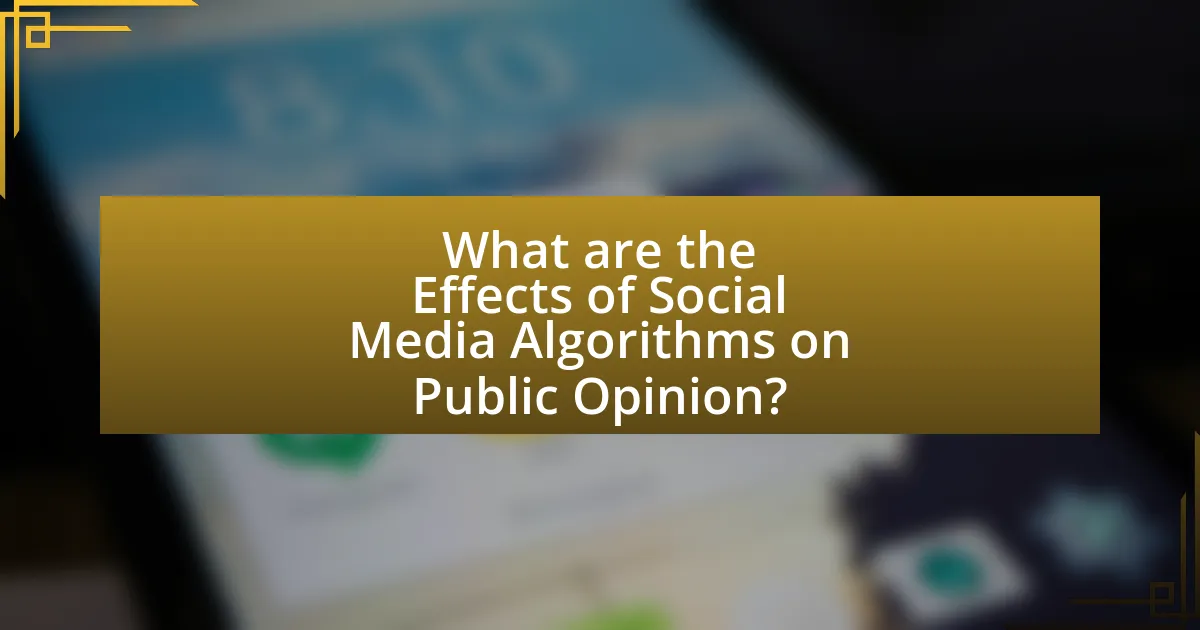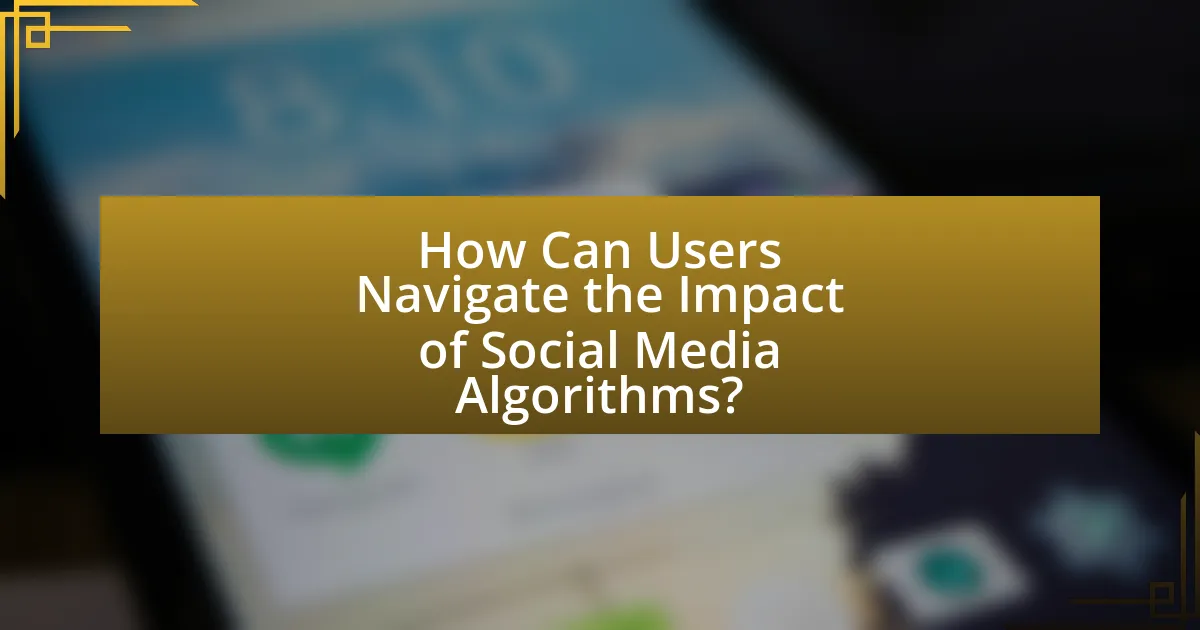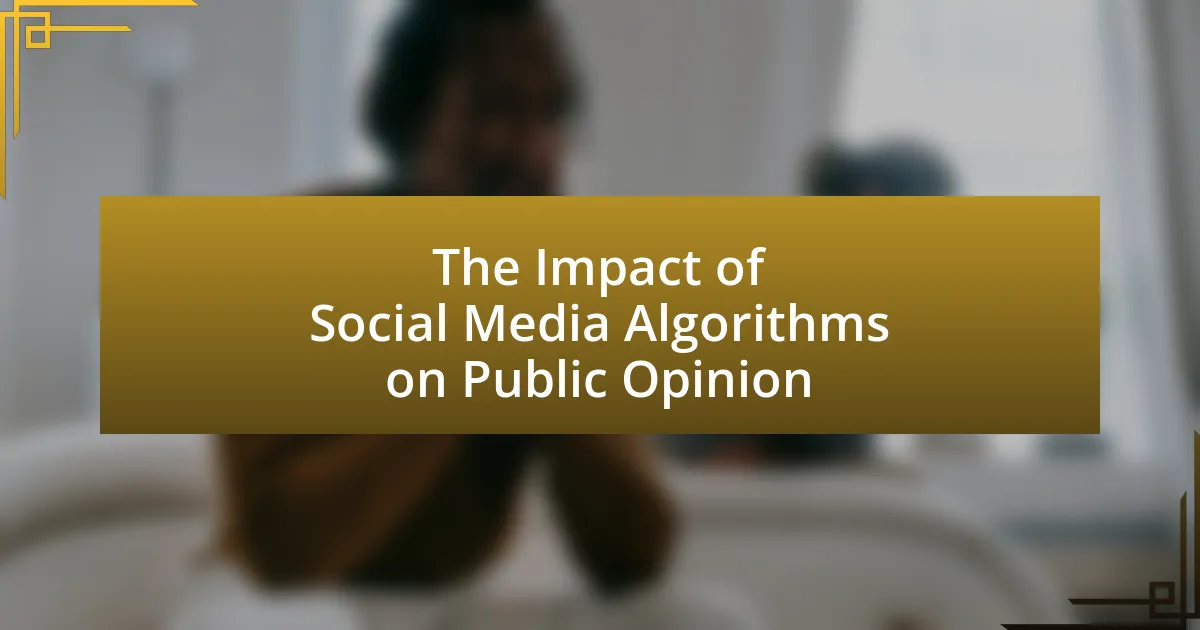Social media algorithms are mathematical formulas that determine the visibility and ranking of content based on user interactions and preferences, significantly influencing public opinion. These algorithms curate personalized feeds, often amplifying content that aligns with users’ interests while suppressing opposing viewpoints, leading to echo chambers and polarization. Research indicates that a substantial portion of the American population believes social media has a negative impact on societal discourse, highlighting concerns about misinformation and the role of algorithms in shaping perceptions. The article explores how these algorithms function, their key components, and their implications for information dissemination, user engagement, and the overall impact on public opinion. Additionally, it discusses strategies for users to navigate algorithmic bias and enhance their digital literacy.

What are Social Media Algorithms and Their Role in Public Opinion?
Social media algorithms are complex mathematical formulas used by platforms to determine the visibility and ranking of content based on user interactions and preferences. These algorithms play a crucial role in shaping public opinion by curating the information users see, often amplifying content that aligns with their interests while suppressing opposing viewpoints. For instance, a study by the Pew Research Center found that 64% of Americans believe social media has a significant impact on their views about political issues, highlighting the influence of algorithm-driven content curation on public perception.
How do social media algorithms function?
Social media algorithms function by analyzing user data to determine which content is most relevant and engaging for each individual user. These algorithms utilize various factors such as user interactions, preferences, and behaviors to curate personalized feeds, ensuring that users see posts that align with their interests. For instance, Facebook’s algorithm prioritizes content that generates high engagement, such as likes, shares, and comments, thereby influencing what users perceive as popular or important. This targeted approach can significantly shape public opinion by amplifying certain viewpoints while minimizing others, as evidenced by studies showing that algorithmic curation can lead to echo chambers and filter bubbles, ultimately affecting societal discourse.
What are the key components of social media algorithms?
The key components of social media algorithms include user engagement metrics, content relevance, and personalization factors. User engagement metrics, such as likes, shares, and comments, help determine the popularity of content, influencing its visibility. Content relevance assesses how well a post aligns with a user’s interests and past behavior, ensuring that users see material that resonates with them. Personalization factors tailor the content feed based on individual user data, including demographics and previous interactions, enhancing user experience and retention. These components collectively shape the information users encounter, significantly impacting public opinion by prioritizing certain narratives and viewpoints over others.
How do algorithms determine content visibility?
Algorithms determine content visibility by analyzing user engagement metrics, relevance signals, and contextual factors. These algorithms prioritize content based on factors such as likes, shares, comments, and the user’s past interactions, which indicate the likelihood of engagement. For instance, Facebook’s algorithm uses a ranking system that weighs these interactions to decide which posts appear in a user’s feed, thereby influencing what content is seen. Research by the Pew Research Center shows that 64% of Americans believe social media platforms have too much control over the news and information they see, highlighting the significant impact of these algorithms on public opinion.
Why are social media algorithms significant in shaping public opinion?
Social media algorithms are significant in shaping public opinion because they determine the content users see, influencing their perceptions and beliefs. These algorithms prioritize posts based on user engagement, which can amplify certain viewpoints while suppressing others, leading to echo chambers. Research by the Pew Research Center indicates that 64% of Americans believe social media has a mostly negative effect on the way things are going in the country, highlighting the power of algorithms in shaping societal narratives.
What impact do algorithms have on information dissemination?
Algorithms significantly influence information dissemination by determining what content users see on social media platforms. These algorithms prioritize engagement metrics, such as likes and shares, which can lead to the amplification of sensational or polarizing content over factual information. For instance, a study by the Pew Research Center found that algorithm-driven feeds can create echo chambers, where users are exposed primarily to viewpoints that reinforce their existing beliefs, thereby shaping public opinion and potentially leading to misinformation spread. This selective exposure can distort users’ perceptions of reality and influence societal discourse.
How do algorithms influence user engagement and behavior?
Algorithms significantly influence user engagement and behavior by personalizing content delivery based on individual preferences and interactions. These algorithms analyze user data, such as likes, shares, and viewing history, to curate a tailored feed that maximizes user retention and interaction. For instance, a study by the Pew Research Center found that 64% of Americans believe social media algorithms lead to a more personalized experience, which can increase the time spent on platforms. This personalized approach can create echo chambers, reinforcing existing beliefs and shaping public opinion, as users are more likely to engage with content that aligns with their views.

What are the Effects of Social Media Algorithms on Public Opinion?
Social media algorithms significantly shape public opinion by prioritizing content that aligns with users’ preferences and behaviors. These algorithms analyze user interactions, such as likes and shares, to curate personalized feeds, which can create echo chambers that reinforce existing beliefs. Research by the Pew Research Center indicates that 64% of Americans believe social media has a mostly negative effect on the way things are going in the country, highlighting concerns about misinformation and polarization. Furthermore, studies show that algorithm-driven content can lead to increased engagement with extreme viewpoints, thereby influencing public discourse and perceptions on critical issues.
How do algorithms create echo chambers?
Algorithms create echo chambers by prioritizing content that aligns with users’ existing beliefs and preferences, thereby limiting exposure to diverse viewpoints. Social media platforms utilize algorithms that analyze user behavior, such as likes, shares, and comments, to curate personalized feeds. This selective exposure reinforces users’ pre-existing opinions, as they are more likely to engage with similar content, creating a feedback loop. Research indicates that this phenomenon can lead to polarization, as users become increasingly isolated from opposing perspectives, ultimately shaping public opinion in a way that favors homogeneity over diversity.
What is the role of confirmation bias in echo chambers?
Confirmation bias plays a crucial role in echo chambers by reinforcing individuals’ pre-existing beliefs and opinions. In echo chambers, social media algorithms curate content that aligns with users’ preferences, leading them to encounter information that confirms their views while filtering out opposing perspectives. This selective exposure strengthens their convictions and diminishes critical thinking, as evidenced by research indicating that individuals are more likely to engage with and share content that supports their beliefs, thereby perpetuating the echo chamber effect. Studies show that this phenomenon can lead to polarization, as users become increasingly isolated from diverse viewpoints, further entrenching their biases.
How do echo chambers affect diverse viewpoints?
Echo chambers significantly limit the exposure to diverse viewpoints by reinforcing existing beliefs and opinions within a closed network. This phenomenon occurs as individuals engage primarily with like-minded peers, leading to a lack of critical discourse and the dismissal of alternative perspectives. Research indicates that social media algorithms prioritize content that aligns with users’ preferences, further entrenching these echo chambers. For instance, a study by Bakshy et al. (2015) published in the Proceedings of the National Academy of Sciences found that Facebook users are more likely to share content that reflects their political beliefs, which contributes to the polarization of opinions and reduces the likelihood of encountering differing viewpoints.
What are the implications of algorithm-driven misinformation?
Algorithm-driven misinformation can significantly distort public perception and influence societal behavior. This distortion occurs as algorithms prioritize sensational or misleading content to maximize engagement, leading users to encounter false narratives more frequently than factual information. Research indicates that misinformation spreads six times faster than accurate news on social media platforms, as shown in a study by Vosoughi, Roy, and Aral published in Science in 2018. The implications include increased polarization, erosion of trust in media and institutions, and potential impacts on democratic processes, as individuals may base decisions on inaccurate information.
How does misinformation spread through social media algorithms?
Misinformation spreads through social media algorithms by prioritizing engagement over accuracy, leading to the amplification of sensational or misleading content. Algorithms are designed to maximize user interaction, often promoting posts that generate strong emotional reactions, regardless of their truthfulness. Research indicates that false information is 70% more likely to be retweeted than true information, as shown in a study published in Science by Vosoughi, Roy, and Aral in 2018. This tendency for algorithms to favor engaging content creates an environment where misinformation can proliferate rapidly, influencing public opinion and shaping perceptions based on inaccurate narratives.
What are the consequences of misinformation on public perception?
Misinformation significantly distorts public perception by shaping beliefs and attitudes based on false or misleading information. This distortion can lead to increased polarization, as individuals may become entrenched in their views, often rejecting factual information that contradicts their beliefs. Research indicates that misinformation spreads more rapidly on social media platforms due to algorithms that prioritize engagement over accuracy, resulting in a misinformed public. For instance, a study published in “Science” by Vosoughi, Roy, and Aral in 2018 found that false news stories were 70% more likely to be retweeted than true stories, illustrating the profound impact of misinformation on public perception.

How Can Users Navigate the Impact of Social Media Algorithms?
Users can navigate the impact of social media algorithms by actively curating their content feeds and engaging with diverse sources. By following a variety of accounts and topics, users can counteract the echo chamber effect often created by algorithms that prioritize familiar content. Research indicates that algorithms tend to reinforce existing beliefs, as seen in a study by Bakshy et al. (2015) published in the Proceedings of the National Academy of Sciences, which found that social media users are more likely to be exposed to information that aligns with their views. Therefore, diversifying the sources of information and regularly interacting with different viewpoints can help users gain a more balanced perspective and mitigate the influence of algorithmic bias on their public opinion.
What strategies can users employ to mitigate algorithmic bias?
Users can mitigate algorithmic bias by diversifying their information sources and actively engaging with content that challenges their perspectives. By seeking out a variety of viewpoints, users can counteract the echo chamber effect often created by algorithms that prioritize familiar content. Research indicates that exposure to diverse opinions can enhance critical thinking and reduce polarization (Pew Research Center, 2020). Additionally, users can adjust their algorithmic settings, such as following different accounts or using tools that promote balanced content, which can help create a more equitable information landscape.
How can users diversify their information sources?
Users can diversify their information sources by actively seeking content from various platforms, including traditional media, independent news outlets, and academic publications. Engaging with different types of media, such as podcasts, blogs, and video channels, allows users to encounter a broader range of perspectives. Research indicates that consuming news from multiple sources can reduce the effects of confirmation bias, which is prevalent in algorithm-driven environments. A study by the Pew Research Center found that individuals who follow diverse news sources are more informed and better equipped to understand complex issues.
What tools are available to analyze algorithmic influence?
Tools available to analyze algorithmic influence include computational frameworks like TensorFlow and PyTorch, which facilitate the modeling of algorithms and their impacts. Additionally, platforms such as Google Analytics and Facebook Insights provide data on user interactions and engagement, allowing researchers to assess how algorithms shape public opinion. Furthermore, specialized tools like CrowdTangle and BuzzSumo enable the tracking of content performance across social media, offering insights into algorithmic effects on visibility and reach. These tools collectively support the analysis of algorithmic influence by providing quantitative data and modeling capabilities essential for understanding the dynamics of social media algorithms on public opinion.
What best practices should users follow for informed engagement?
Users should follow best practices such as critically evaluating sources, diversifying information consumption, and engaging in respectful discourse for informed engagement. Critically evaluating sources involves checking the credibility and reliability of information before sharing or acting on it, which is essential given that misinformation can spread rapidly on social media platforms. Diversifying information consumption means seeking out various perspectives and sources to avoid echo chambers, as studies show that exposure to diverse viewpoints can enhance understanding and reduce polarization. Engaging in respectful discourse encourages constructive conversations, which can lead to more informed opinions and a healthier public dialogue. These practices are supported by research indicating that informed engagement can mitigate the negative effects of social media algorithms on public opinion.
How can users critically evaluate content on social media?
Users can critically evaluate content on social media by assessing the credibility of the source, analyzing the evidence presented, and recognizing potential biases. Evaluating the source involves checking the author’s qualifications, the publication’s reputation, and whether the information is corroborated by other reliable outlets. Analyzing evidence includes looking for data, statistics, or references that support claims made in the content. Recognizing biases requires users to consider the language used, the framing of the information, and the potential motivations behind the content, such as political or commercial interests. Research indicates that users who engage in these practices are more likely to form informed opinions and resist misinformation, as highlighted in studies on media literacy and critical thinking.
What role does digital literacy play in understanding algorithms?
Digital literacy is essential for understanding algorithms as it equips individuals with the skills to critically analyze and interpret the data-driven processes that govern online content. This understanding enables users to recognize how algorithms influence the information they encounter, particularly on social media platforms, which can shape public opinion. Research indicates that individuals with higher digital literacy are better at discerning the biases and limitations of algorithms, leading to more informed engagement with digital content. For instance, a study by the Pew Research Center found that 64% of Americans believe that social media platforms have a significant impact on the way news is consumed, highlighting the importance of digital literacy in navigating these algorithmic influences.

Leave a Reply